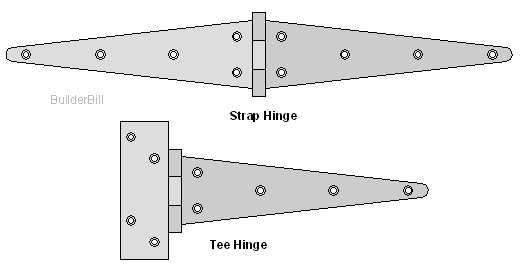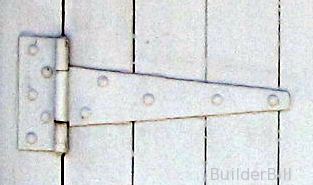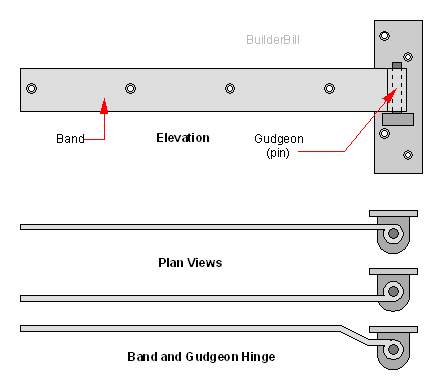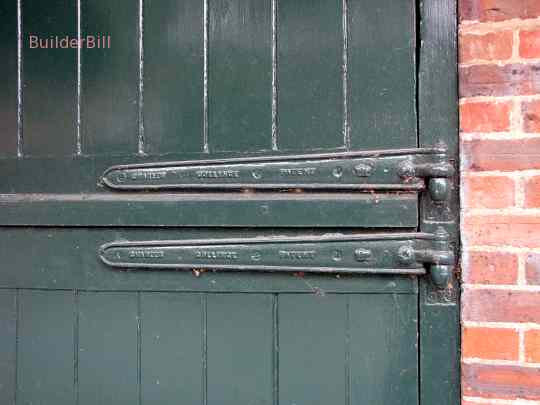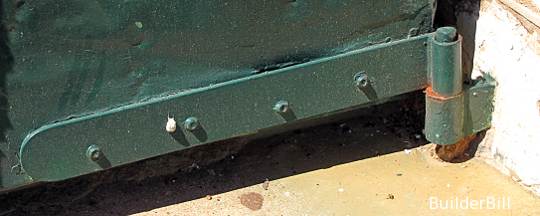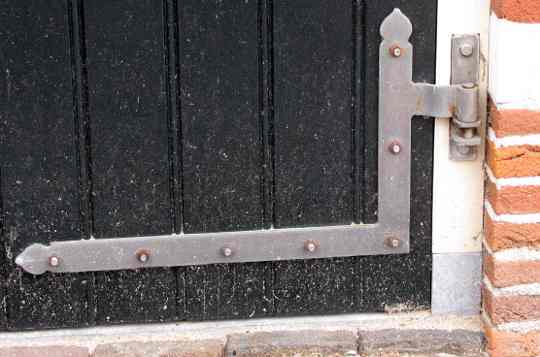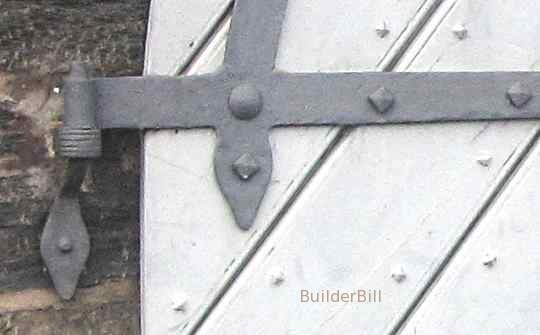 |
|||||||||||||||
Graphical Construction Glossary >> Doors. >> Door Hinges >> Strap Hinges
The strap and the tee hinge are usually associated with budget priced hinges that are punched out of thin flat steel plate.
All the hinges shown on this page are known as face fixing. That is they fix to either face of a door rather than the edge of a door like a butt hinge. This makes for very easy fixing. The door is simply held in the right position and then the hinges are screwed on. Very easy considering the widespread use of tek screws and screwdriver guns. In one respect they are all "strap Hinges" in that they have a flat strap of metal to at least one leaf of the hinge. However there are other more specific names. They are all much used on external doors like batten doors Also as a general term they sometimes get referred to as gate hinges. That is the lightweight variety anyway. For heavier gates see the industrial hinges page.
If the doors are heavier it is quite normal to fix some screws to hold everything in position and then drill through hinge and door to be able to use say two bolts per hinge instead of screws. A similar thing may be done at the door frame. Drill out a couple of holes wider in the hinge and then fix coach bolts for greater strength.
In general band and gudgeon hinges are typically heavier duty and for larger doors than the strap or tee hinges. They can also be considered in many case as Lift Off Hinges Some of the more expensive ones have screw caps to the top of the pin. The band and gudgeon hinge type are very simple. In the sketch I have drawn one that has screw fixing to a wooden door frame. The standard band can be fixed two ways by simply flipping the way that the band is placed on the pin. Quite often though it is necessary to crank the bands to achieve the desired offset between the face of the door and the centre line of the pin.
Again here we have an easy fixing to a door and wooden door jamb or frame. The manufacturer has made the hinges with a slight crank so that the faces of the door and jamb will be flush with each other.
Slightly harder to fix are hinges like this that are fixed to masonry. Different fittings entirely are used on the pin end and accuracy is important as adjustments are hard to make once the fixing to the masonry is done.
The large steel hinge above is on a fairly old commercial building and it is on an opening that nowadays would have something like a modern roller door to it. I am not to sure if these hinges were built by a metal working shop as a one off, or if they were commercially produced, but they are of a recurring style used on many large old wooden doors. They provide the hinge function and they also act as stiffening and bracing the heavy door. Note again the need to crank the band, and the use of coach bolt to the pin fixing.
An old door fixed directly to masonry again. This time because the pin centre line is a fair way out from the wall face the maker has provided a brace to give added support where it is needed. This hinge photo could just have easily been on the previous page as it is a good example of practical wrought iron work. These wrought iron spike were often fixed to the masonry in a very secure way. The hole was drilled an a small rolled up piece of sheet lead was placed into the hole. The wrought iron spike which would have been square in section was then driven into the lead. Some modern small nail fasteners still use this ability of lead to be driven into tight conformity to the hole and spike. If you didn't find exactly what you are looking for try this search tool that will search the site and the web. "What can be added to the happiness of a man who is in health, out of debt, and has a clear conscience? "When we build, let us think that we build for ever."John Ruskin 1819-1900 |
Hire Equipment  Furniture Fittings - Architectural Hardware - Electronic Locking Systems - Technical Hardware BuilderBill sponsorship Glossary Pages.Roof Glossary and Roofing Formwork Glossary and other tempory work. Hand Tools Glossary Power Tools Glossary Asbestos Glossary Woodwork Glossary Stair Glossary Concrete Glossary Masonry Glossary doors Glossary BuilderBill Books Building Maths  Stair Design  Asbestos Book |
||||||||||||||
|
|
|||||||||||||||
|
Please Note! The information on this site is offered as a guide only! When we are talking about areas where building regulations or safety regulations could exist,the information here could be wrong for your area. It could be out of date! Regulations breed faster than rabbits! You must check your own local conditions. Copyright © Bill Bradley 2007-2012. All rights reserved. |
|||||||||||||||
